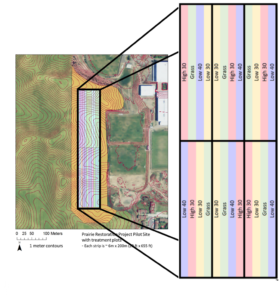 A team of EWU biology students and faculty members recently achieved a significant milestone in Eastern’s ongoing Prairie Restoration Project.
A team of EWU biology students and faculty members recently achieved a significant milestone in Eastern’s ongoing Prairie Restoration Project.
Working earlier this fall, the group drill-seeded four different treatments of high-density and low-density mixtures of seeds and forbs to cover the full extent of the project’s 13-acre test area, a patch of former wheat field just west of the EWU soccer facility. The mixes include a biodiverse array of plants that are native to the Northern Palouse prairie. The test area is now completely planted and carefully labeled for accurate evaluation.
The new cultivations also encompass a 1.5-acre plot that was hand planted last winter. That initial planting was intended to cover the entire test site, but heavy rains oversaturated the site’s clay-laden soil, making it impossible to move trucks and other machinery around the site.
Rather than lose a growing season, students and faculty hand-planted a smaller portion of the test plot. Unfortunately, the heavy rain soon yielded to drought, a circumstance that meant the seeding wasn’t as successful as hoped. But the planting did manage to propagate some native grasses – a result that led restoration team members to conclude that, going forward, they could safely assume such grasses would be easier to establish than flowering plants.
In addition, the initial 1.5-acre planting continues to yield educational benefits. Because it can take up to four years for native seeds to germinate and develop sustainable root structures and shoots, students are continually gaining insights from this living laboratory.
Ultimately, restoration-related research will serve as an important tool in helping EWU students, scientists and conservation experts dig deeper into the fascinating complexities of the Palouse Prairie ecosystem. It’s an outcome, project team members say, that will significantly advance our understanding and appreciation of this vital regional landscape. View photos here.


